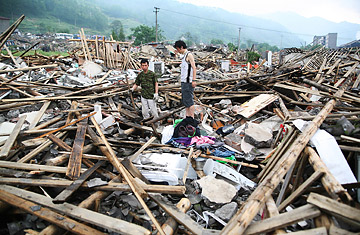
Earthquake survivors try to salvage what they can from their destroyed houses in the Ronghua Township of Shifang, China.
(3 of 4)
The sociologists expected to see evidence of selfish behavior. But they did not. "People kept talking about the orderliness of it all," says Feinberg. "People used what they had learned in grade-school fire drills. 'Stay in line. Don't push. We'll all get out.' People were queuing up! It was just absolutely incredible."
All of us, but especially people in charge — of a city, a theater, a business — should recognize that people can be trusted to do their best at the worst of times. They will do even better if they are encouraged to play a significant role in their own survival before anything goes wrong. In New York City, despite the pleas of safety engineers, meaningful fire drills are still not mandatory in skyscrapers. Among other concerns, the city's Real Estate Board was worried that mandatory drills could lead to injuries that could lead to lawsuits. A lawsuit, then, is more frightening than a catastrophe, which is a shame. Because if a real disaster should come to pass, people will rise to the expectations set by their CEO or headwaiter, and they will follow their leader almost anywhere.
How One Person Made a Difference
In every disaster, buried under the rubble is evidence that we can do better. Much of that work is physical — building stronger buildings in safer places, for example. But the work is also psychological. The more control people feel they have over their predicament, the better their performance. When people believe that survival is negotiable, they can be wonderfully creative. All it takes is the audacity to imagine that our behavior matters.
When the planes struck the Twin Towers on Sept. 11, 2001, Rick Rescorla embodied that spirit of survival. The head of security for Morgan Stanley Dean Witter at the World Trade Center, Rescorla believed that regular people were capable of great achievements, with a bit of leadership. He got Morgan Stanley employees to take responsibility for their survival — which happened almost nowhere else that day in the Trade Center.
Rescorla learned many of the tricks of survival in the military. He was one of those thick-necked soldier types who spend the second halves of their lives patrolling the perimeters of marble lobbies the way they once patrolled a battlefield. Born in England, he joined the U.S. military because he wanted to fight the communists in Vietnam. When he got there, he earned a Silver Star, a Bronze Star and a Purple Heart in battles memorialized in the 1992 book by Lieut. General Harold G. Moore and Joseph L. Galloway, We Were Soldiers Once ... and Young.
He eventually moved to New Jersey and settled into the life of a security executive, but Rescorla still acted, in some ways, like a man at war. His unit, Morgan Stanley, occupied 22 floors of Tower 2 and several floors in a nearby building. After the 1988 bombing of Pan Am Flight 103 over Lockerbie, Scotland, Rescorla worried about a terrorist attack on the Trade Center. In 1990, he and an old war buddy wrote a report to the Port Authority of New York and New Jersey, which owns the Trade Center site, insisting on the need for more security in the parking garage. Their recommendations, which would have been expensive, were ignored, according to James B. Stewart's biography of Rescorla, Heart of a Soldier. (The Port Authority did not respond to my requests for comment.)
Three years later, Ramzi Yousef drove a truck full of explosives into the underground parking garage of the World Trade Center, just as Rescorla had predicted. Afterward, Rescorla had the credibility he needed. Combined with his muscular personality, it was enough to change the culture of Morgan Stanley.
Rescorla implicitly understood that he could turn office workers into survivors. He respected the ability of regular people to do better. He understood the danger of lethargy, the importance of aggressively pushing through the initial stupor and getting to action. He had watched employees wind down the staircase in 1993, and he knew it took too long.
Rescorla felt it was foolish to rely on first responders to save his employees. His company was the largest tenant in the Trade Center, a village nestled in the clouds. Morgan Stanley's employees would need to take care of one another. He ordered them not to listen to any instructions from the Port Authority in a real emergency. In his eyes, it had lost all legitimacy after it failed to respond to his 1990 warnings. And so Rescorla started running the entire company through his own frequent, surprise fire drills. He trained employees to meet in the hallway between the stairwells and go down the stairs, two by two, to the 44th floor.
The radicalism of Rescorla's drills cannot be overstated. Remember, Morgan Stanley is an investment bank. Millionaire, high-performance bankers on the 73rd floor did not appreciate the interruption. Each drill, which pulled brokers off their phones and away from their computers, cost the company money. But Rescorla did it anyway. His military training had taught him a simple rule of human nature: the best way to get the brain to perform under extreme stress is to repeatedly run it through rehearsals beforehand.
After the first few drills, Rescorla chastised employees for moving too slowly in the stairwell. He started timing them with a stopwatch, and they got faster. He also lectured employees about some of the basics of fire emergencies: Because roof rescues are rare and extremely dangerous, people should always go down.
